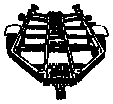Trailering Safety

The Trailer
Your trailer is an important part of your boating equipment. It should be the proper size and length to fit your boat. The rollers should be spaced to provide adequate support to the hull with some positioned under specific stress points, i.e. under engine mounts or fuel tanks, etc. Tie downs are needed to secure the boat on the trailer. Check the trailer’s data plate for load and tire information.
Tongue Weight
Only 5 to 7 percent of the total trailer weight should be on the hitch. Too little tongue weight will cause the trailer to fishtail. Too much weight will impair steering.

Brakes
Brakes are required if your trailer is rated for three thousand pounds or more. They must be on all axles. They can be either surge brakes or electric brakes.
Lights
Trailers must be equipped with signal lights, tail lights, brake lights and a license plate light. All must be in working order. Waterproof fixtures should be used and bulbs should be allowed to “cool down” before submersing underwater.
Safety Chains
Two chains strong enough to hold the total trailer weight should be securely attached to the trailer. The chains, when attached to the frame of the tow vehicle, should form an X below the tongue. In the event that the hitch becomes undone, the chains will prevent the tongue from digging into the pavement and flipping the trailer over.

Tires & Wheel Bearings
Tires should have good tread and be inflated to proper levels. The sidewalls should be inspected for “dry rot” and cracking. Carry a spare wheel, jack, lug nut wrench, and spare wheel bearings. The bearings should be packed with fresh grease at the beginning of every season. “Bearing Buddies” will allow you to keep the bearings greased more often.
Tow Vehicle
Check the hitch to be sure it is the proper class and ball size for the trailer. Too much weight on the hitch will cause the rear wheels of the tow vehicle to drag and may make steering more difficult. You may need certain additions such as a transmission line cooler, heavy-duty suspension and cooling system, flashers or mirrors.

Towing
Due to the added length and boat weight you’ll find that vehicles handle differently when towing. It will take you longer to accelerate and to stop - you should leave a safer stopping distance. Corners will need to be taken a little wider. Practice backing up with a trailer. Remember, the trailer will turn in the opposite direction from the car. Avoid sudden stops and radical lane changes. Remember to secure all items which could blow out of the boat when trailering.
Launching & Retrieving Boat Launch Etiquette
-
Prepare your boat for launch at the top of the top of the ramp.
-
Remove tie-down straps - PUT IN THE DRAIN PLUG - disconnect the wiring harness to the trailer lights.
-
Never leave vehicle unattended at the ramp. Set your packing brake and put vehicle in “park”.
-
In retrieving your boat, make certain the boat is placed properly on the trailer. DO NOT POWER DRIVE THE BOAT ONTO THE TRAILER.
-
Secure the winch strap onto the bow eye and pull the boat up steadily.
Trailering Videos
CHECK LIST |
||
|---|---|---|
|
|
|
|
|
|
|
|
|
|
|
|
|
|
|
|
|
|

